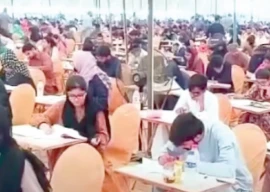
Roland deSouza has done some math: Sindh's new law on high density amounts to 5% of the upper income folks planning at the expense of 95% of the poor.
The law, the Sindh High Density Development Board Act, was passed in 2010 as the then president Asif Zardari pushed the agenda. It allows the Sindh government to earmark zones in Karachi (and other cities in Sindh) for high-rise buildings. So, for example, if you live in Clifton and own a residential plot on a strip that has been declared part of the high-rise zone, you could have a 50-storey building go up next door and not be able to say anything about it. This will affect entire neighbourhoods. In fact, at Abdullah Shah Ghazi's shrine one example is coming up next to Neelum Colony at what was A. T. Naqvi chowk, and another example is coming up opposite Barbeque Tonight.
What I have not understood is why there has not been more opposition to this new law. An amendment was passed in 2013 changing the arrangement of the board. It sailed through. Should the government be passing such laws without debate? If memory serves correctly, it sailed through the Sindh Assembly four years ago when first introduced. Why were the recommendations from the planners, elicited in 2009 while preparing the law, not taken into account? They held a press conference in June 2010 after the bill was passed on May 31.
In the fourth installment of this five-part series, The Express Tribune asks the experts to assess our outlook on Karachi when it comes to making such laws on planning, by what appear to be the "rich" and "powerful". The debate series was started by Lahore-based urbanist Ahmad Rafay Alam after experts Roland deSouza of NGO Shehri and Arif Belgaumi gave a public presentation on the legislation. In order to answer Rafay Alam's questions, we asked Karachi planner and researcher Arif Hasan and Belgaumi to weigh in.
DAY 4
Rafay Alam

Lawyer, environmentalist and activist
Another issue I have about this planning elite-despite the fact that they are irrelevant (irrelevant doesn't mean you are wrong; it means you are not influential enough) - is that they think the problems of Karachi, or any other city for that matter, can be solved through planning. Planning is only one of the components of actual governance. Instead, to me it sounds like a turf war, with architects questioning folks in the urban planning and local government trenches, with the architects shouting "listen to us" while not realizing the mind-boggling complexity of managing and financing a city of [over] 20 million people. Shouldn't the lack of their influence be measured against the value of their message? I know this gets me into some complicated territory regarding all sorts of issues such as the importance of sustainability or environment regulation. But I think asking questions like this exposes everyone to the truth: How our cities are actually run, what they do, whether they are safe and allow every one of their residents equal opportunities.
Arif Hasan

Architect & planner, activist, teacher, social researcher & writer
Planning is primarily a political process. If a space for consensus exists, planning is more equitable. If it does not exist, the only way the poorer sections of the population have had their way is through demonstrations, strikes and violence. Karachi's "civil society" has not tried to create a space for consensus but has argued its case very powerfully with like-minded people as an audience. The katchi abadi dwellers have done much better but that is because their numbers are large and as such they have to be listened to. Also, they have not asked for the moon and have cultivated a working relationship with their politicians.
Arif Belgaumi

Practising architect and teaches architectural design at the Indus Valley School of Art and Architecture
It is simplistic to talk about the planning elite and so-called DHA architects. I don't believe there is such a turf war, primarily because most architects are not actively interested in addressing issues at the city planning level. The solutions to the complexities of city planning and management are political. It is not for nothing that the words metropolis and politics share the same root. Planning and design are important tools in devising political solutions in the public interest.
Published in The Express Tribune, October 6th, 2014.
COMMENTS (2)
Comments are moderated and generally will be posted if they are on-topic and not abusive.
For more information, please see our Comments FAQ

1732170891-0/BeFunky-collage-(79)1732170891-0-165x106.webp)

1729234806-0/Robert-Pattinson-(2)1729234806-0-165x106.webp)













@ashar: and the 'credit' will go to citizens of this Godforsaken city.What a shame.
Karachi will be remembered as the most forsaken city of the world. Much more than Dilli.